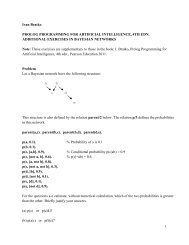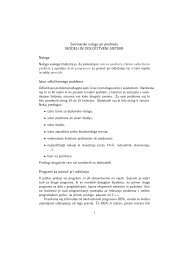Detecting Fortresses in Chess
Detecting Fortresses in Chess
Detecting Fortresses in Chess
You also want an ePaper? Increase the reach of your titles
YUMPU automatically turns print PDFs into web optimized ePapers that Google loves.
40 GUID, BRATKO<br />
Figure 9. Backed-up heuristic evaluation of the RYBKA (left) and HOUDINI (right) chess programs for twelwe positions that<br />
were regarded as fortresses by GM Dvoretsky.<br />
beneficial to analyse all possible moves up to some<br />
feasible search depth. If some move demonstrates positive<br />
changes <strong>in</strong> backed-up evaluations with an <strong>in</strong>creas<strong>in</strong>g<br />
level of search, it may be useful to devote more attention<br />
to such a move.<br />
Future work may <strong>in</strong>clude a more detailed formulation<br />
of the algorithm for detect<strong>in</strong>g fortresses, its implementation<br />
<strong>in</strong> a chess program, and its evaluation on a statistically<br />
significant set of test cases. Also, more empirical<br />
evidence would be helpful <strong>in</strong> order to determ<strong>in</strong>e whether<br />
the proposed method can be afforded by chess programs<br />
under various time constra<strong>in</strong>ts <strong>in</strong> a tournament play.<br />
However, the method as presented <strong>in</strong> this paper<br />
can already be useful, for example, <strong>in</strong> correspondence<br />
chess or at compos<strong>in</strong>g chess studies, where a humancomputer<br />
<strong>in</strong>teraction is of great importance, and the time<br />
available is significantly larger than <strong>in</strong> ord<strong>in</strong>ary chess<br />
competitions. In the era of strong chess eng<strong>in</strong>es, one<br />
of the important roles of a human <strong>in</strong> correspondence<br />
chess is to guide the eng<strong>in</strong>e(s) to the most promis<strong>in</strong>g<br />
cont<strong>in</strong>uations. One of the conclusions of this paper<br />
useful for competitors <strong>in</strong> correspondence chess is that<br />
a certa<strong>in</strong> cont<strong>in</strong>uation may not be w<strong>in</strong>n<strong>in</strong>g, when the<br />
backed-up evaluations, although stay<strong>in</strong>g high, cease to<br />
<strong>in</strong>crease <strong>in</strong> further play.<br />
The f<strong>in</strong>d<strong>in</strong>gs presented <strong>in</strong> this paper also represent a<br />
contribution to the understand<strong>in</strong>g of the computer heuristic<br />
search <strong>in</strong> general. Namely, if backed-up heuristic<br />
evaluations of seem<strong>in</strong>gly promis<strong>in</strong>g alternatives (e.g., for<br />
solv<strong>in</strong>g a particular problem) cease to <strong>in</strong>crease between<br />
successive depths of search, such alternatives may not<br />
be promis<strong>in</strong>g at all – even if the correspond<strong>in</strong>g backedup<br />
heuristic values obta<strong>in</strong>ed by heuristic search are<br />
extremely high.<br />
REFERENCES<br />
[1] M. Dvoretsky, Dvoretsky’s Endgame Manual, 2nd edition. Russell<br />
Enterprises, Inc., 2008.<br />
[2] L. Kocsis, C. Szepesvári, Bandit based Monte-Carlo Plann<strong>in</strong>g.<br />
The European Conference on Mach<strong>in</strong>e Learn<strong>in</strong>g, pp. 282–293,<br />
Spr<strong>in</strong>ger, 2006.<br />
[3] M.H. W<strong>in</strong>ands, Y. Björnsson, J. Saito, Monte-Carlo Tree Search<br />
Solver. Computers and Games, Lecture Notes <strong>in</strong> Computer<br />
Science, vol. 5131, Spr<strong>in</strong>ger, 2008.<br />
[4] R. Coulom, Efficient selectivity and backup operators <strong>in</strong> Monte-<br />
Carlo tree search. Computers and Games, Lecture Notes <strong>in</strong><br />
Computer Science, vol. 4630, Spr<strong>in</strong>ger, 2007.<br />
[5] M. Guid, Search and Knowledge for Human and Mach<strong>in</strong>e<br />
Problem Solv<strong>in</strong>g. Ph.D. Thesis, University of Ljubljana, 2010.<br />
Matej Guid received his B.Sc. (2005) and Ph.D. (2010) degrees <strong>in</strong><br />
computer science at the University of Ljubljana, Slovenia. He is a<br />
researcher at the Artificial Intelligence Laboratory, University of Ljubljana.<br />
His research <strong>in</strong>terests <strong>in</strong>clude heuristic search, computer gameplay<strong>in</strong>g,<br />
automated explanation and tutor<strong>in</strong>g systems, and argumentbased<br />
mach<strong>in</strong>e learn<strong>in</strong>g. <strong>Chess</strong> has been one of his favorite hobbies<br />
s<strong>in</strong>ce childhood. He was also a junior champion of Slovenia a couple<br />
of times, and holds the title of FIDE master.<br />
Ivan Bratko received his B.Sc. (1970) and M.Sc. (1975) degrees<br />
<strong>in</strong> electrical eng<strong>in</strong>eer<strong>in</strong>g from the Faculty of Electrical Eng<strong>in</strong>eer<strong>in</strong>g,<br />
and the Ph.D. degree from the Faculty of Computer and Information<br />
Science (1978), all from the University of Ljubljana. He is professor<br />
at the Faculty of Computer and Information Science, University of<br />
Ljubljana. He is the head of Artificial Intelligence Laboratory s<strong>in</strong>ce<br />
1985; he also collaborates with Department of Intelligent Systems at<br />
the Jozef Stefan Institute. He is full member of the Slovenian Academy<br />
of Sciences and Arts (SAZU) s<strong>in</strong>ce 2003, and member of Academia<br />
Europaea (s<strong>in</strong>ce 2010). He received the ambassador <strong>in</strong> science award<br />
from Republic of Slovenia (1991), became a Fellow of ECCAI (European<br />
Coord<strong>in</strong>ation Committee for Artificial Intelligence) <strong>in</strong> 2001, and<br />
received the Zois award for outstand<strong>in</strong>g scientific achievements from<br />
the state of Republic of Slovenia <strong>in</strong> 2007. His best known work is<br />
the book Prolog Programm<strong>in</strong>g for Artificial Intelligence (4th edition,<br />
Addison-Wesley 2011).





